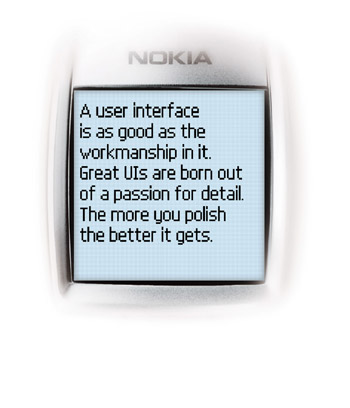The More You Polish the Better It Gets
|
|

>>>——Original Message——
>>>From: NN (NMP-RD/Espoo)
>>>Sent: 23. May 2000 15:38
>>>To:
>>>Subject: Right alignment of digits
>>>
>>>Hello Super Gurus,
>>>
>>>Why are we aligning the phone numbers to the right when everything >>>else is on the left? I was thinking that you must know the reason. Is the >>>right alignment a Nokia heritage holy cow, that must be maintained no >>>matter what? Otherwise, are there any real reasons to keep it right >>>aligned (except that changing from right to left would mean more work >>>for SW)? >>>
>>>Background information:
>>>
>>>The right alignment may cause some problems when we start adding >>>more functionality to the idle display. . . . The functionality will overlap >>>with digit entry for call making.
>>>
>>>BR,
>>>NN
>>——Original Message——
>>From: NN (NMP/Salo)
>>Sent: 24 May, 2000 14:52
>>To: . . .
>>Subject: RE: Right alignment of digits
>>
>>Hi all,
>>
>>my understanding of the history (for a more authoritative one we should >>ask NN):
>>
>>In the Good Old Days phone displays were damn small and could only fit >>a few characters, it was hard to do any layout design at all, but right >>alignment was probably one way to improve the user experience, because:
>>-when the number was so long that all of it could not fit on the display
>>the software would naturally drop the first digits, which were considered >>less important for the user. (For names, the beginning is more important).
>>-It is also a way to make a visual difference between number and name >>modes.
>>
>>And I do agree that there is no real reason to keep the tradition alive any >>more.
>>
>>BR,
>> -N
>——Original Message——
>From: NN (NMP/Copenhagen)
>Sent: 24 May, 2000 16:26
>To: . . .
>Subject: RE: Right alignment of digits
>
>Hi there,
>
>Good points, N
>My ‘guess’ would have been:
>
>-Heritage at that time (1991 or so) was probably mainly derived from >calculators (and NMT phones, where the digits come from right :-)
>-Most competitors did it that way back then (and they still do)
>
>I didn’t quite get how right alignment conflicts with your concept.
>
>BRN
——Original Message——
From: NN (NMP/Salo)
Sent: 25. May 2000 10:55
To: . . .
Subject: RE: Right alignment of digits
Hi Gents,
Before we do anything else, let’s see a simulation or test software with the proposed change. Maybe it’s a case of “not broken, don’t fix it.” And we have plenty of genuine UI problems right now.
Benefits to making the change might be enhanced if we had some automatic number grouping (which is, I know, never perfect, but which might help the one true annoyance, which is that it is hard to check a very long number without losing your place).
If you want history, letting numbers come from a different corner from Alphas gives users a subtle, subconscious clue to whether he’s in a number or alpha entry mode. Your eye knows exactly where to find the digit that you just entered. This is a bit different psychologically from alpha entry. In alpha entry you see where you are by “reading” from left to right, the whole thing each time. In number entry, if you do NOT have nice short number grouping, you tend to check and confirm one digit at a time. And the lower right position for the number echoes the format of the name and number in the phone book display, and how numbers are entered in calculator mode. It does not echo date or time entry.
I love these detailed esoteric UI discussions. These details are what have made our UIs the best. I hope someday we actually start spending time on them again! Meanwhile . . . is full of small besser-wisser irritations which were originally corrected 10 years ago (such as stupid extra notes everywhere, or that horrible beep when battery is full!!!!). Let’s fix those first please!
User interface design is about constructing links from the big picture to the smallest detail. The wireless communication technology itself is layered. There are the capabilities of GSM, CDMA, GPRS, WCDMA, and other mobile protocols that are utilized within the limits of memory, display, and the capabilities of different terminals as specified by the user interface design. There are the mobile content providers and operators who are creating a selection of mobile services that appear to the end user to be specified by the user interface design. There is the user in a cultural context with more or less practical needs, which are being fulfilled to the extent specified by the user interface design. There are several chains of reasoning that lead, at the end of the day, to pixel-level UI solutions. Understanding where the chains come from is important, but still, the devil is in the details.
It is never easy to see the big picture, but sometimes it seems easier than designing the details. However, that’s probably because there is help available for the big picture. We can consult marketing research, business analysis, and roadmapping to illuminate future trends. When it comes to the details, though, the full responsibility is on user interface designers and usability specialists.
Seen from the level of a product vision, problems with the details may seem trivial—it is, after all, just a matter of packing things into space, time, and hierarchies. However, the user interface is as good as the details in it, and the product is as good as the user interface.
|
|
EAN: 2147483647
Pages: 142